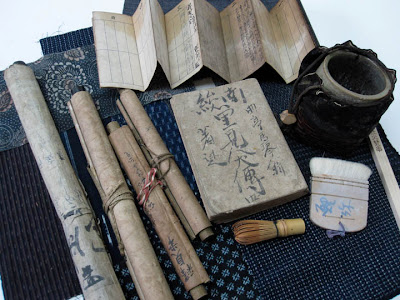Donna Watson, The Ancient Way, 20"x20"
Creativity is an integral part of being human, as basic as walking, talking and thinking. The creative process is intuitive. It points us towards our essential nature. Zen teachings can help us understand and cultivate our creativity.
Donna Watson, page from handmade book, MEMORY LANDSCAPE
Zen is about experience and activity and not about words and ideas that try to describe it. THE TAO OF PAINTING, a book written around 500 C.E. is a classic canon on the art of painting as a spiritual path. In the action of no-action (wu-wei) the mind is silenced and the work is allowed to express itself.
Donna Watson, image of tools and journal pages
Zen masters began to use art as a way of teaching enlightenment. Zen arts, creativity and realized spirituality are seen as inseparable. Zen aesthetic developed to express eternal truths about the nature of reality and our place in the universe.
Donna Watson image, sunrise, view from my bedroom window
These Zen arts do not exist for the purpose of creating a work of art, but rather a method for opening the creative process. They comprise means of training the mind and living our lives. These arts were called ways because they were disciplines or paths to the artist's understanding of him or herself. The suffix "do" means way.
Donna Watson, image of ways to create new art works from flea market finds
Chado, the way of tea. The ritual of the tea ceremony (simplicity, purity) influences all of Japan's fine arts. Creating harmony with opposites is an important aspect. Inside the tea room, it is important to display a piece of calligraphy in harmony with the spirit of the tea and an ikebana (flower arrangement) in a pure and simple style.
image from Museum of Fine Arts Boston website
image via Flickr, fujijardins, Thierry Del Socorro
image via Flickr, fujijardins, Thierry Del Socorro
Shodo, the way of the brush. Calligraphy is a striving for inner perfection, yet it is always incomplete, open like the enso (circle) of infinity. Shodo is a discipline that takes many years to master. It is a way to enlightenment.
calligraphy tools
an ancient pond/ a frog jumps in/ the splash of water.. Matsuo Basho, 1686
Ginkaku-ji temple, Kyoto, Japan, by David M. Bryne
Kado, the way of the flower. Ikebana or flower arranging is another art form that incorporates harmony and balance.
Toshiro Kawase
The emphasis is on the creative process--- not on technical skill. The creative process is unique to each individual. It is unique to YOU. The creative process helps each of us discover our own way of expression.
image via Flickr, lightsongs, Kerry Singh
This process of discovery is the endless spring of creativity. It is already present in each of us, waiting to be uncovered. Ultimately, the experience of the arts helps us to see into one's own heart and mind and to bring to life that which is realized.














